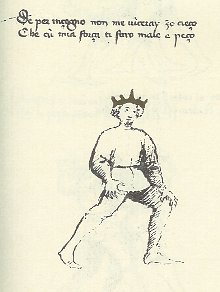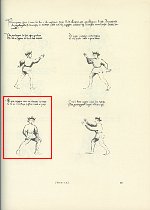| Fiore dei Liberi: Flos Duellatorum, 1410 (Pisani-Dossi, F. Novati, Bergamo, 1902) |
| 1.0 quatro poste - four guards |
1.0.3 porta de ferro  (iron gate) (iron gate) |


Se per incegno non me uinceray zo acto
Che cum mia forza ti faro male e peco. |
I know that with cunning you will not beat me
that with my strength I will hurt you and break you. |
Interpretation: The first line of the couplet, assuming the translation is relatively good, implies that the porta de ferro offers the best defensive strategy from which to either defend against most attacks or deploy an offense thwarting any attempts on the master. The second line of the couplet appears to imply that a successful maneuvre from the porta de ferro can only be done with physical "strength", however, this can also be interpreted as the "strength" of all combat attributes which would come to bear when deploying an offense or creating a defense. Fiore discusses the four great warrior attributes, and fortitudo is only one of the four attributes, and there are no cases in which a single attribute becomes the only attribute in any given situation. All attributes come to bear, but one or more are greater while others are less, but none are ever excluded. Click on the images view a larger image of the same.
Application: The porta de ferro illustrated depicts the master with both hands positioned approximately waist height, hands relaxed, left leg forward and right leg trailing. The footing can also be reversed. The weight is distributed over the left leg and the trailing foot on the ball of the foot with heel slightly raised, legs slightly bent and back straight creating a posture which is prepared to leap into action, whether offensive or defensive.
example applications
| Section |
Play |
Carta |
| |
|
|
 (iron gate)
(iron gate) (iron gate)
(iron gate)